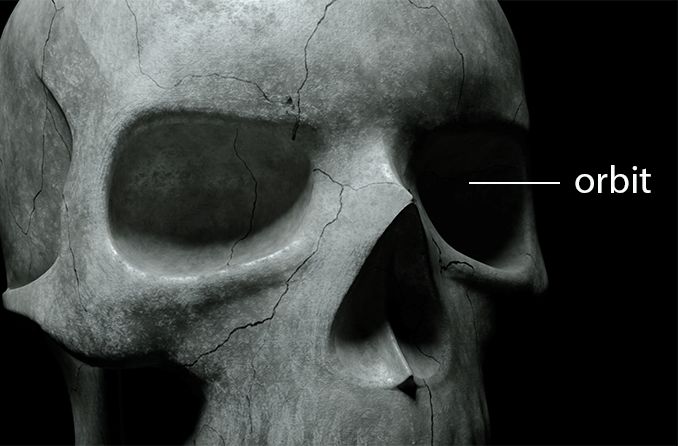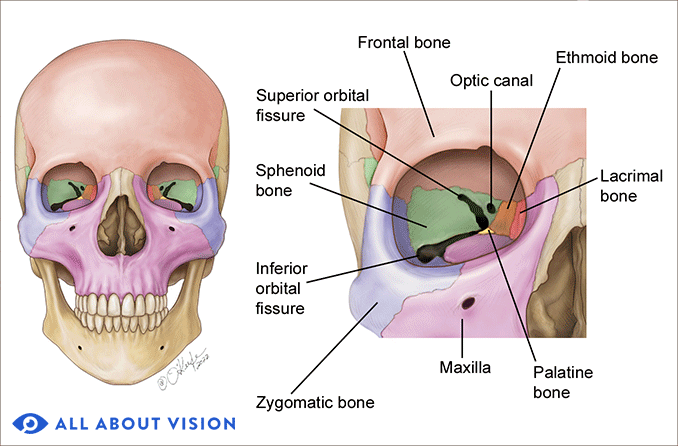What is an orbital bone, and what happens when an orbital bone breaks?

The “orbit” or “socket” of the eye encases the eyeball and protects its place in the skull. The structure of the orbit is made up of several orbital bones that provide a strong base for the eye so that it can perform its functions properly.
There are seven orbital bones that make up this structure: the frontal, sphenoid, zygomatic, ethmoid, lacrimal, palatine and maxilla bones. Each of these plays a role in keeping the eyeball protected.
Though small, the orbital bones are quite strong to protect the eye inside the head.
What is the function of the orbit?

Illustrated by Laurie O'Keefe
The main function of the orbit and orbital bones is to keep the eyeball protected and positioned properly within the skull. With the support of the orbital structure, the eyeball is able to move and function healthily.
The structure of the orbit also connects the eye to the optic nerve and to critical veins and arteries, as well as to the tear duct, through several pathways.
READ NEXT: What is hypertelorism?
What is an orbital bone fracture?
An orbital bone fracture or break is what it sounds like: a broken orbital bone (or multiple bones). This is frequently the result of an accident, such as a car wreck or being hit hard by a flying object (for example, a baseball during a ballgame). Broken orbital bones can also happen if you come into contact with the force of someone’s fist.
There are three main types of orbital fractures — blowout, orbital floor and orbital rim — in which any or all of the bones can be affected.
Blowout fracture
A blowout fracture can be the result of being hit in the eye with a baseball or a fist. This type of fracture affects the orbit’s inner wall and can impact the muscles that support the movement of the eye — which can make it difficult to move your eye properly.
Orbital floor fracture
Significant eye trauma can cause the orbital bone and surrounding structures to cave downward into the socket. Such trauma can also affect the surrounding eye muscles, making eye movement harder and more painful.
Orbital rim fracture
Orbital rim fractures typically result from car accidents and similar traumatic events. This type of fracture affects the outer part of the orbital bone and is usually caused by a great deal of force or impact. Depending on the manner of trauma, orbital rim fractures may be associated with other facial injuries.
SEE RELATED: Safety glasses and protective eyewear
How does an orbital bone fracture affect vision?
Depending on the severity, vision can be affected by an orbital bone injury or fracture. In general, orbital bone injuries can cause blurry vision, difficulty moving the eye and bruising around the eye.
More serious impacts on the orbital bone can cause other symptoms, such as:
Numbness
Blood in the eye (subconjunctival hemorrhage)
Swelling in and around the eye
SEE RELATED: 7 common eye injuries and how to treat them
How is an orbital bone injury treated?
If an orbital bone or the area around it is injured, it should be checked by an ophthalmologist as soon as possible for signs of a fracture or break. Evaluating an orbital bone typically involves tests such as a CT scan, X-rays and other imaging.
Many cases do not require surgery for treatment, and the eye is able to heal on its own with the help of antibiotics, decongestants and ice packs to reduce swelling. Severe orbital bone fractures that impact the movement of the eye (or that cause the eyeball to be repositioned) are more likely to require surgery.
The bruising and swelling caused by an orbital fracture usually heals within seven to 10 days, while the fracture itself takes longer to heal completely — the exact time frame depends on the level of impact and severity of the injury.
Orbital bones: crucial to supporting eye health
Orbital bones provide a base within the skull for the eyeball to rest, allowing the eye to move and function properly. This structure is designed to provide strong protection for your eyes in the event of head trauma or injury, though sometimes the bones themselves can sustain a fracture.
Though orbital fractures do not always require surgery for treatment, it is important for your eye doctor to take note of it in your medical history — it may be a threat to your eye health in the future.
When the eyeball is properly supported by the orbital structure, it can function on its own, connect to critical veins and arteries, and promote healthy overall vision.
SEE RELATED: Cavernous sinus thrombosis
Page published on Wednesday, January 27, 2021




